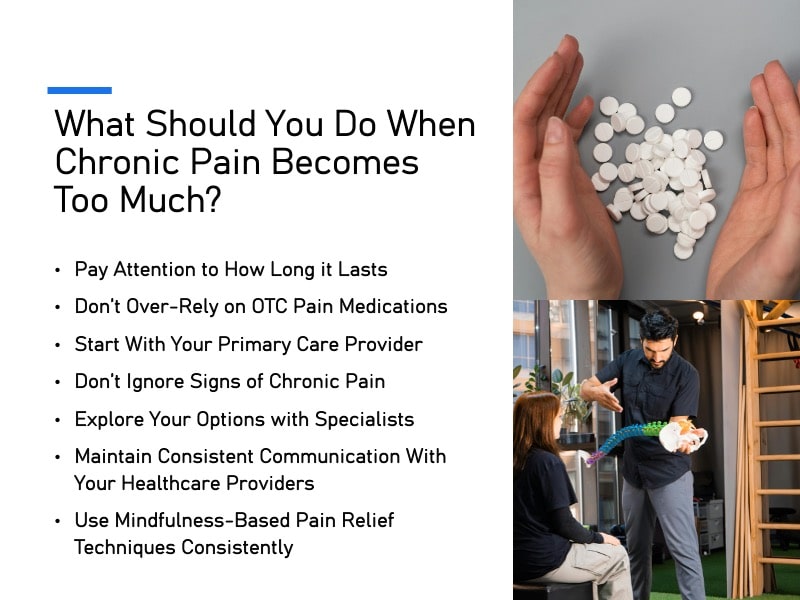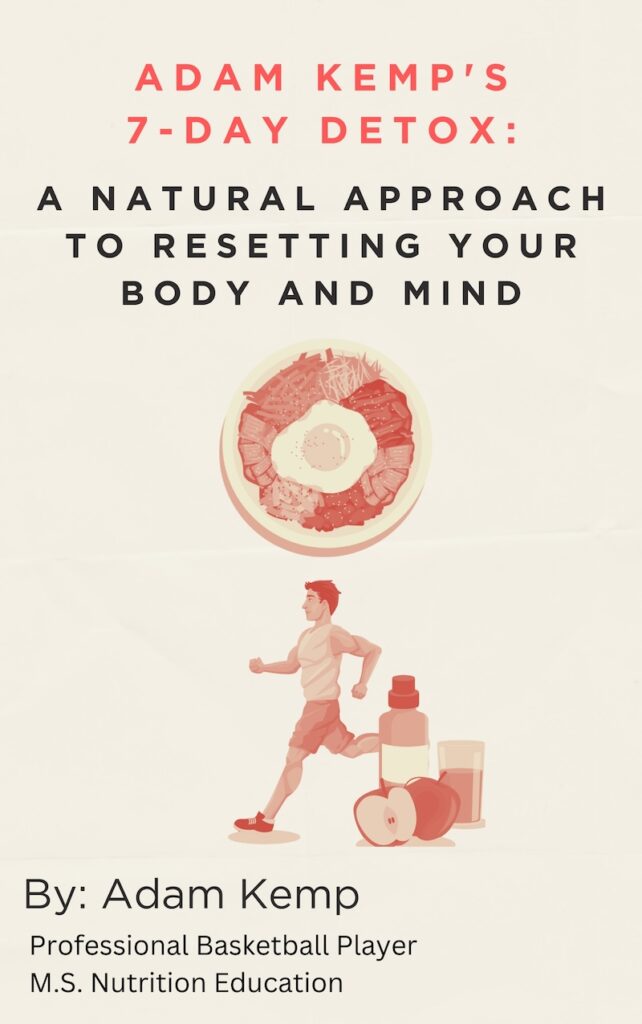What to Do When Chronic Pain Becomes Too Much
When chronic pain becomes too much to manage with rest, ice, or over-the-counter remedies, it’s a sign that deeper intervention is needed.
Unlike temporary soreness, chronic pain can quietly undermine every aspect of life, from mobility and sleep to mental health and daily responsibilities.
When this discomfort persists for weeks or months, it can disrupt your work, relationships, and emotional resilience.
Understanding the distinction between acute injuries and ongoing problems is essential for effective chronic pain management.
Recognizing when it’s time to seek professional help, exploring available treatment options, and advocating for your needs are all critical steps toward regaining control.
Knowing what to do when chronic pain becomes too much can make the difference between ongoing struggle and the start of meaningful relief.
What is Chronic Pain?
Chronic pain is pain that lasts for 12 weeks or longer, even after the original injury or cause has healed.
It can range from mild to severe and often interferes with daily activities, sleep, and mental health.
What Causes Chronic Pain?
Chronic pain can be caused by a wide range of factors, including past injuries, ongoing inflammation, nerve damage, autoimmune disorders, or underlying conditions like arthritis, fibromyalgia, or migraines.
In some cases, the cause may be unclear, but the nervous system continues to send pain signals long after the initial issue has resolved.
How to Manage Chronic Pain on Your Own?
To manage chronic pain on your own, focus on consistent lifestyle strategies that reduce inflammation and support your nervous system:
- Exercise gently and regularly, such as walking, swimming, or resistance band work, to improve mobility and release endorphins.
- Prioritize sleep by maintaining a regular routine and creating a calming environment to help the body heal.
- Use relaxation techniques like deep breathing, progressive muscle relaxation, or mindfulness meditation to calm the stress response.
- Adopt an anti-inflammatory diet rich in whole foods, healthy fats, lean proteins, and antioxidants.
- Track pain patterns using a journal or app to identify triggers and measure what strategies bring relief.
- Limit alcohol and avoid smoking, both of which can worsen chronic pain symptoms.
These approaches support both physical and emotional well-being and are foundational to chronic pain self-management.
What Should You Do When Chronic Pain Becomes Too Much?

When chronic pain becomes too much to bear, it’s a signal that your current coping strategies may no longer be enough.
At this stage, pushing through or hoping it improves on its own can lead to worsening symptoms and emotional exhaustion.
Instead, it’s crucial to take action by seeking medical guidance, exploring new treatment options, and building a support system are all essential steps to regain control and improve your quality of life.
Pay Attention to How Long it Lasts
Pain that lasts for a few days after a tough workout (known as delayed onset muscle soreness, or DOMS), or a long day of moving around, isn’t unusual, but pain that sticks around for weeks or even months is a different story (Cheung et al., 2003).
That’s the kind of discomfort that deserves more than just stretching or hoping it passes with time.
The key is noticing patterns and changes.
If something hurts more over time, limits movement, or comes with numbness or tingling, it’s worth getting checked out.
The earlier someone speaks up, the easier it is to find out what’s going on and explore options.
Don’t Over-Rely on OTC Pain Medications
While over-the-counter options like ibuprofen, Tylenol, Aleve, and Advil can provide short-term relief, using them too often may damage your stomach lining, disrupt your gut microbiome, and mask deeper issues.
Some people explore more natural alternatives like CBD for pain relief, but it’s essential to speak with your doctor before making any changes.
Important: Always follow medical advice and use pain medications as directed within a broader, doctor-approved chronic pain management plan.
Start With Your Primary Care Provider
Before jumping into specialist care, most people start by visiting their regular doctor to talk through what they’re feeling.
This can be helpful in narrowing down the possible causes and determining if further steps are necessary.
A good conversation with a primary care provider often sets the stage for everything that comes next.
If the pain is more than what general treatment can handle, a referral may follow.
That’s often the first move toward working with someone who focuses on treating specific kinds of pain and injuries.
Don’t Ignore Signs of Chronic Pain
Some types of pain come and go, but others stick around in a way that slowly chips away at daily comfort.
Chronic back pain, for instance, can affect sleep, focus, posture, and mood, turning what used to be normal days into frustrating ones.
When pain becomes a constant companion, people often try to adjust or live around it, but that only delays the support they really need.
Recognizing the difference between temporary soreness and long-term discomfort can help people take control of the situation before it gets worse.
Explore Your Options with Specialists
When basic treatment doesn’t help, it might be time to connect with experts who deal with pain every day.
This could involve visiting a clinic that specializes in joints, bones, and movement, or consulting with pain management professionals who utilize a broader range of tools.
Some of the top orthopedic surgeons have experience treating complex issues that don’t respond well to rest, physical therapy, or standard medication.
While surgery isn’t always the answer, it’s helpful to understand all the options and ask questions about what might work best.
Maintain Consistent Communication With Your Healthcare Providers
Once treatment begins, it’s important to stay in touch with your healthcare team and let them know what’s working and what isn’t.
Pain relief isn’t always immediate, and adjustments along the way can make a big difference in how well someone recovers.
Being honest about discomfort, mobility, or side effects helps everyone stay on the same page.
Chronic pain recovery is rarely a straight line, but consistent communication between doctor and patient keeps things moving in the right direction.
Use Mindfulness-Based Pain Relief Techniques Consistently
Mindfulness isn’t just a stress-reduction tool; it’s a proven method for managing chronic pain when used regularly.
Research has shown that mindfulness practices, including mindful breathing, body scans, and meditation, can significantly reduce pain sensitivity by altering how the brain processes pain signals (Zeidan et al., 2015).
These techniques help shift attention away from the discomfort and reduce the emotional reactivity that often amplifies pain.
However, consistency is key.
Practicing mindfulness for just 10–20 minutes a day can gradually rewire the neural pathways involved in pain perception, promoting a calmer and more adaptive response to chronic pain.
Whether through guided meditations, mindfulness-based stress reduction (MBSR) programs, or simple daily check-ins with your body, incorporating mindfulness into your routine can transform how you experience pain, even when chronic pain becomes too much.
Final Thoughts: Can You Live Pain-Free After Dealing with Chronic Pain?
When chronic pain becomes too much, it’s natural to wonder if living pain-free is even possible.
While chronic pain often doesn’t disappear entirely, research shows that a combination of evidence-based treatments, such as physical therapy, cognitive behavioral therapy, medication, and lifestyle adjustments, can dramatically reduce pain levels and restore function.
Neuroplasticity, or the brain’s ability to rewire pain pathways, also plays a key role in long-term recovery.
Success often depends on early intervention, a multidisciplinary approach, and a personalized pain management plan tailored to each individual’s needs.
With the right strategies and support, many people find lasting relief even after chronic pain becomes too much to handle alone.
This website does not provide medical advice. This website site does contain affiliate links, and purchases may earn a commission.
Read my Medical Disclaimer, Review Disclaimer, and Publishing Policies for more details. Use of this site indicates acceptance of these terms.



